
Original Link: https://www.anandtech.com/show/2848
AMD’s Radeon HD 5850: The Other Shoe Drops
by Ryan Smith on September 30, 2009 12:00 AM EST- Posted in
- GPUs
AMD’s Radeon HD 5850: The Other Shoe Drops
“For those of you looking for the above and a repeat of the RV770/GT200 launch where prices will go into a free fall, you’re going to come away disappointed. That task will fall upon the 5850, and we’re looking forward to reviewing it as soon as we can.”
-From our Radeon HD 5870 Review
Today the other shoe drops, with AMD launching the 5870’s companion card: the slightly pared down 5850. It’s the same Cypress core that we saw on the 5870 with the same features: DX11, Eyefinity, angle-independent anisotropic filtering, HDMI bitstreaming, and supersample anti-aliasing. The only difference between the two is performance and power – the 5850 is a bit slower, and a bit less power hungry. If by any chance you’ve missed our Radeon HD 5870 review, please check it out; it goes in to full detail on what AMD is bringing to the table with Cypress and the HD 5800 series.
| ATI Radeon HD 5870 | ATI Radeon HD 5850 | ATI Radeon HD 4890 | ATI Radeon HD 4870 | |
| Stream Processors | 1600 | 1440 | 800 | 800 |
| Texture Units | 80 | 72 | 40 | 40 |
| ROPs | 32 | 32 | 16 | 16 |
| Core Clock | 850MHz | 725MHz | 850MHz | 750MHz |
| Memory Clock | 1.2GHz (4.8GHz data rate) GDDR5 | 1GHz (4GHz data rate) GDDR5 | 975MHz (3900MHz data rate) GDDR5 | 900MHz (3600MHz data rate) GDDR5 |
| Memory Bus Width | 256-bit | 256-bit | 256-bit | 256-bit |
| Frame Buffer | 1GB | 1GB | 1GB | 1GB |
| Transistor Count | 2.15B | 2.15B | 959M | 956M |
| TDP | 188W | 151W | 190W | 150W |
| Manufacturing Process | TSMC 40nm | TSMC 40nm | TSMC 55nm | TSMC 55nm |
| Price Point | $379 | $259 | ~$180 | ~$160 |
AMD updated the specs on the 5850 at the last moment when it comes to power. Idle power usage hasn’t changed, but the final parts are now specified for 151W load power, versus the 160W originally given to us, and 188W on the 5870. So for the power-conscious out there, the 5850 offers a load power reduction in lockstep with its performance reduction.
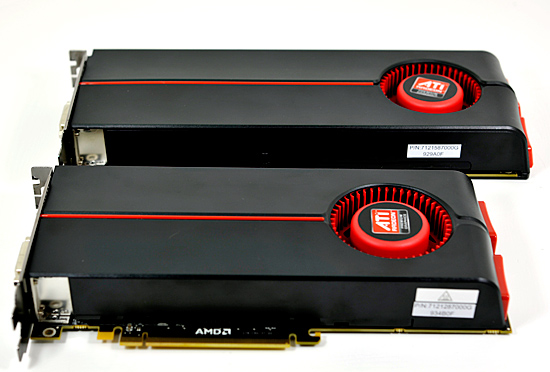
As compared to the 5870, AMD has disabled two of the SIMDs and reduced the core clock from 850MHz to 725Mhz. This is roughly a 15% drop in clock speed and a 10% reduction in SIMD capacity, for a combined theoretical performance difference of 23%. Meanwhile the memory clock has been dropped from 1.2GHz to 1GHz, for a 17% overall reduction. Notably the ROP count has not been reduced, so the 5850 doesn’t lose as much rasterizing power as it does everything else, once again being 15% due to the drop in clock speed.
With the reduction in power usage, AMD was able to squeeze Cypress in to a slightly smaller package for the 5850. The 5850 lobs off an inch in length compared to the 5870, which will make it easier to fit in to cramped cases. However the power connectors have also been moved to the rear of the card, so in practice the space savings won’t be as great. Otherwise the 5850 is a slightly smaller 5870, using the same sheathed cooler design as the 5870, sans the backplate.

Port-side, the card is also unchanged from the 5870. 2 DVI ports, 1 HDMI port, and 1 DisplayPort adorn the card, giving the card the ability to drive 2 TMDS displays (HDMI/DVI), and a DisplayPort. As a reminder, the DisplayPort can be used to drive a 3rd TMDS display, but only with an active (powered) adapter, which right now still run at over $100.
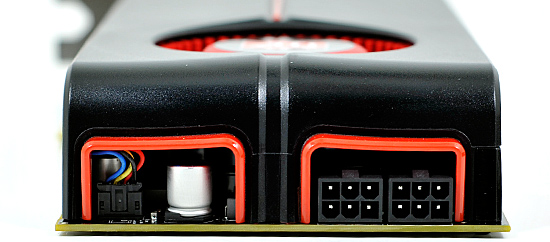
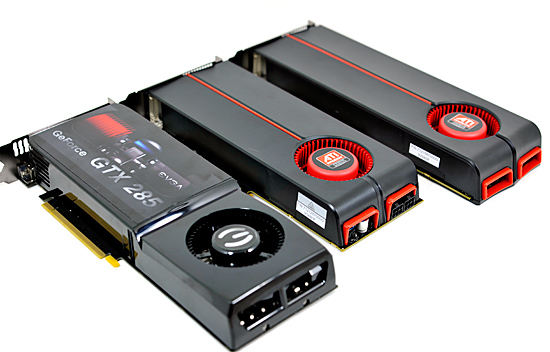
Battleforge: The First DX11 Game
As we mentioned in our 5870 review, Electronic Arts pushed out the DX11 update for Battleforge the day before the 5870 launched. As we had already left for Intel’s Fall IDF we were unable to take a look at it at the time, so now we finally have the chance.
Being the first DX11 title, Battleforge makes very limited use of DX11’s features given that the hardware and the software are still brand-new. The only thing Battleforge uses DX11 for is for Compute Shader 5.0, which replaces the use of pixel shaders for calculating ambient occlusion. Notably, this is not a use that improves the image quality of the game; pixel shaders already do this effect in Battleforge and other games. EA is using the compute shader as a faster way to calculate the ambient occlusion as compared to using a pixel shader.
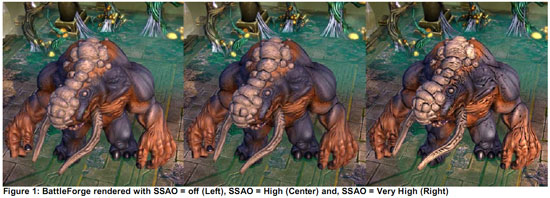
The use of various DX11 features to improve performance is something we’re going to see in more games than just Battleforge as additional titles pick up DX11, so this isn’t in any way an unusual use of DX11. Effectively anything can be done with existing pixel, vertex, and geometry shaders (we’ll skip the discussion of Turing completeness), just not at an appropriate speed. The fixed-function tessellater is faster than the geometry shader for tessellating objects, and in certain situations like ambient occlusion the compute shader is going to be faster than the pixel shader.
We ran Battleforge both with DX10/10.1 (pixel shader SSAO) and DX11 (compute shader SSAO) and with and without SSAO to look at the performance difference.
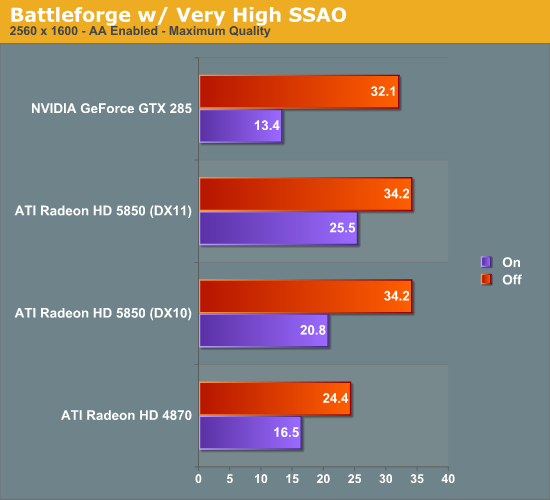
Update: We've finally identified the issue with our results. We've re-run the 5850, and now things make much more sense.
As Battleforge only uses the compute shader for SSAO, there is no difference in performance between DX11 and DX10.1 when we leave SSAO off. So the real magic here is when we enable SSAO, in this case we crank it up to Very High, which clobbers all the cards as a pixel shader.
The difference from in using a compute shader is that the performance hit of SSAO is significantly reduced. As a DX10.1 pixel shader it lobs off 35% of the performance of our 5850. But calculated using a compute shader, and that hit becomes 25%. Or to put it another way, switching from a DX10.1 pixel shader to a DX11 compute shader improved performance by 23% when using SSAO. This is what the DX11 compute shader will initially be making possible: allowing developers to go ahead and use effects that would be too slow on earlier hardware.
Our only big question at this point is whether a DX11 compute shader is really necessary here, or if a DX10/10.1 compute shader could do the job. We know there are some significant additional features available in the DX11 compute shader, but it's not at all clear on when they're necessary. In this case Battleforge is an AMD-sponsored showcase title, so take an appropriate quantity of salt when it comes to this matter - other titles may not produce similar results
At any rate, even with the lighter performance penalty from using the compute shader, 25% for SSAO is nothing to sneeze at. AMD’s press shot is one of the best case scenarios for the use of SSAO in Battleforge, and in the game it’s very hard to notice. For the 25% drop in performance, it’s hard to justify the slightly improved visuals.
The Test
We are once again using beta driver version 8.66 for this review, the same drivers we used for the 5870. We should see the first WHQL driver next month in Catalyst 9.10.
| CPU: | Intel Core i7-920 @ 3.33GHz |
| Motherboard: | Intel DX58SO (Intel X58) |
| Chipset Drivers: | Intel 9.1.1.1015 (Intel) |
| Hard Disk: | Intel X25-M SSD (80GB) |
| Memory: | Patriot Viper DDR3-1333 3 x 2GB (7-7-7-20) |
| Video Cards: |
ATI Radeon HD 5870 |
| Video Drivers: |
NVIDIA ForceWare 190.62 |
| OS: | Windows 7 Ultimate 64-bit |
Crysis: Warhead
Kicking things off, we’ll start with Crysis: Warhead. Warhead is still the single most demanding game in our arsenal, with cards continuing to struggle to put out a playable frame rate with everything turned up.
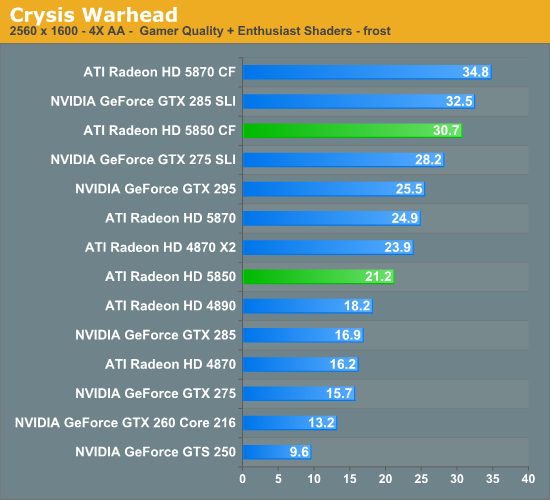
With Crysis: Warhead being so GPU limited, we see a pretty standard breakdown of GPU performance. The 5850 loses only to the 5870 for single-GPU cards. The 5850 Crossfire on the other hand gives us some surprising results, losing to the GTX 285 in SLI in spite of a single 5850 beating a single GTX 285. Clearly NVIDIA is getting better multi-GPU scaling out of Warhead than AMD is.
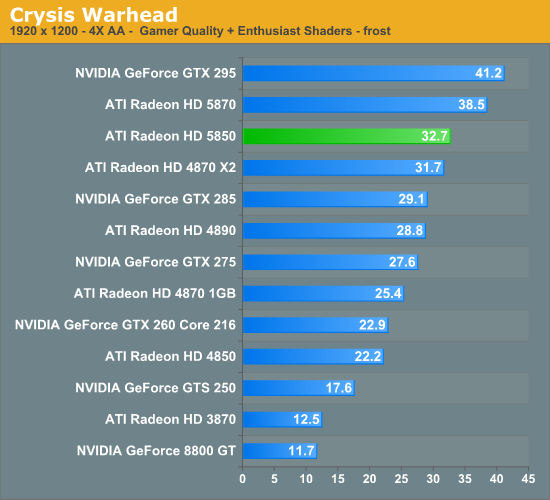
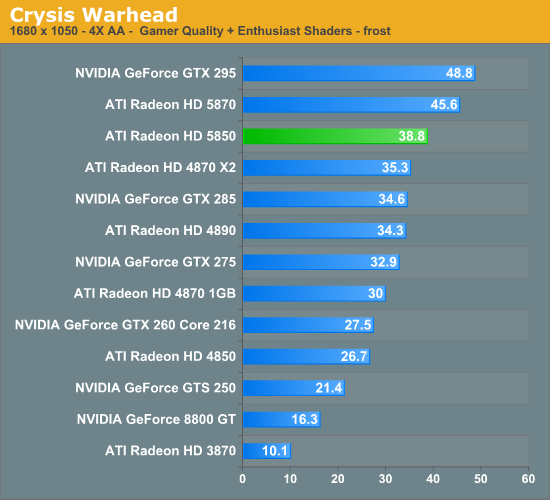
Far Cry 2
Far Cry 2 is another foliage-heavy game. Thankfully it’s not nearly as punishing as Crysis, and it’s possible to achieve a good framerate even with all the settings at their highest.
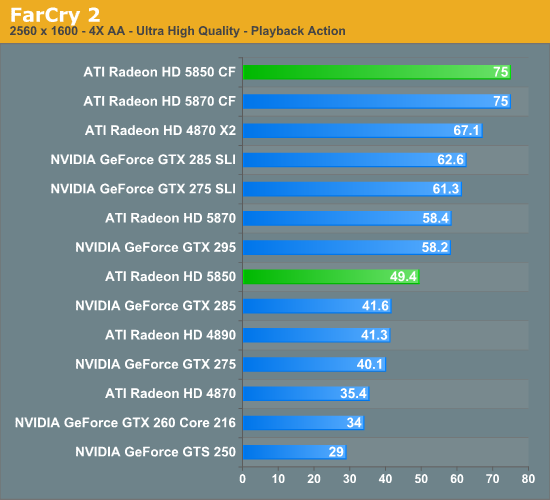
Have you ever wondered about what point Far Cry 2 becomes CPU limited? Well now we know. The 5850 in Crossfire manages to turn in the same score as the 5870 in Crossfire: 75fps. We’re CPU limited even at these high resolutions and settings.
Meanwhile the 5850 hits the mark AMD is shooting for, coming in some 20% higher than the GTX 285 and overshadowed only by the 5870 and multi-GPU setups.
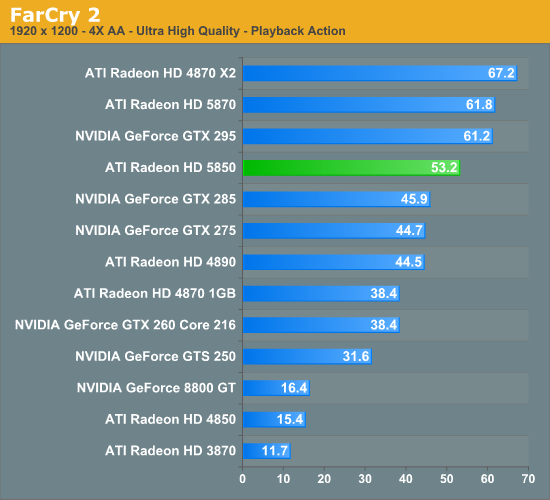
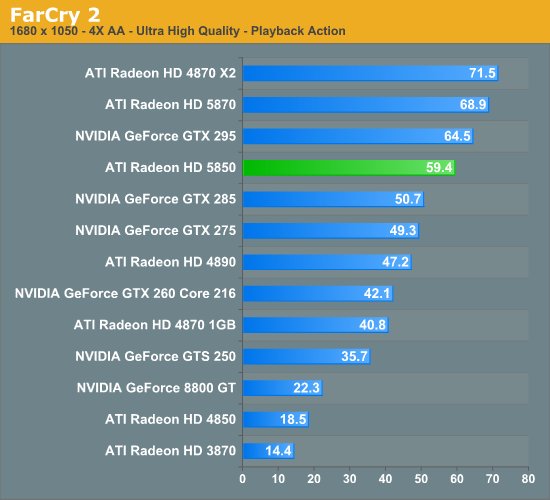
Battleforge
As we discussed Battleforge, EA’s DirectX11-enabled card-based online-only RTS earlier in this article, here’s a repeat of the benchmarks for those of you that missed them.

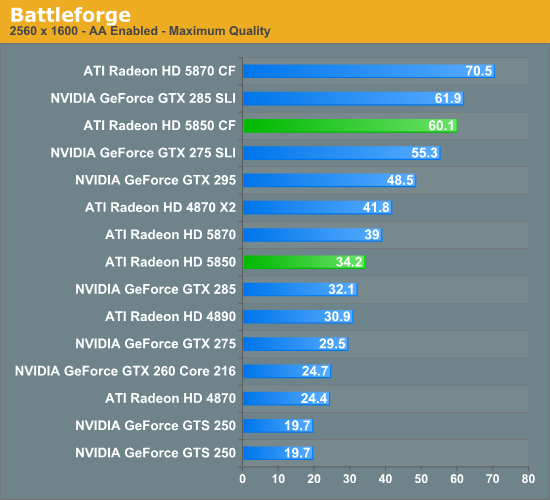
With and without ambient occlusion, the 5850 comes in right where we expect it. The 5850 Crossfire on the other hand loses once again to the GTX 285 SLI in spite of beating the GTX 285 in a single card matchup. With SSAO enabled however, the performance hit is rather severe.
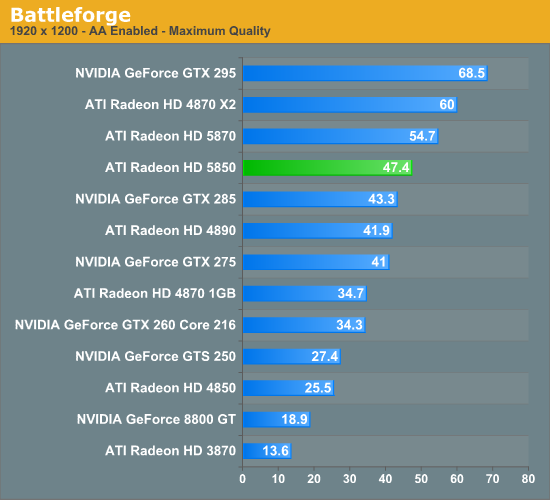
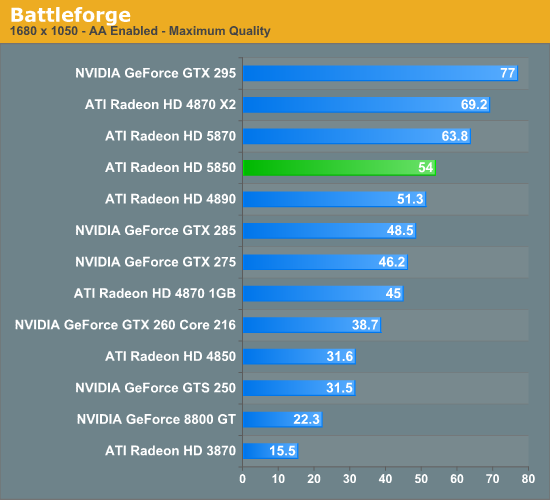
World of Warcraft
Blizzard’s genre-dominating MMO is our next benchmark. As WoW is known to be CPU limited, we can turn it up to rather silly settings and still get a playable framerate on just about anything.
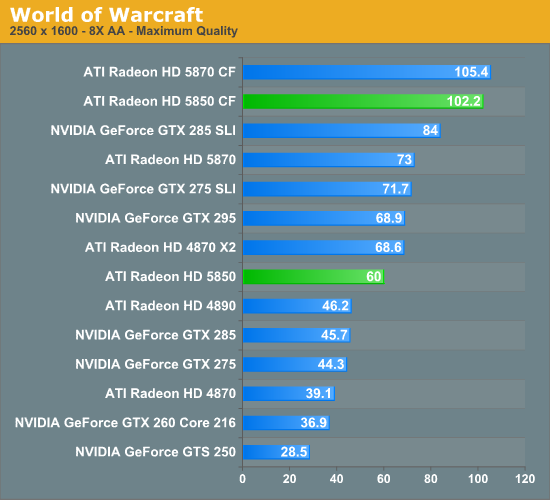
For whatever reason the 5800 series cards do particularly well here. Even the 5850 can completely decimate the GTX 285, both in single card and Crossfire/SLI configurations. You can see the CPU limitations in this game come to light, as at the very top the 5870 and 5850 are nearly tied.
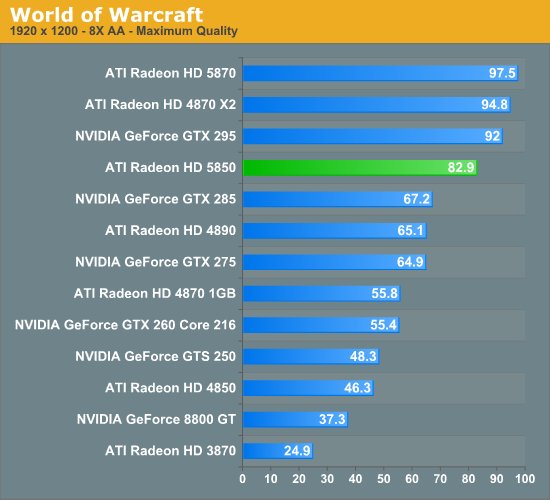
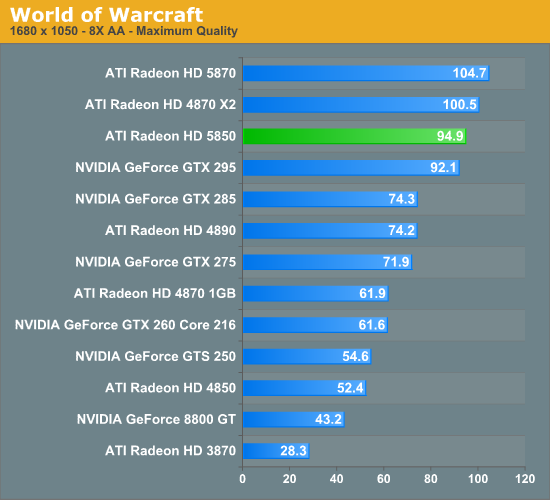
HAWX is another game that’s not particularly GPU-bound, which means we can turn in some high numbers.
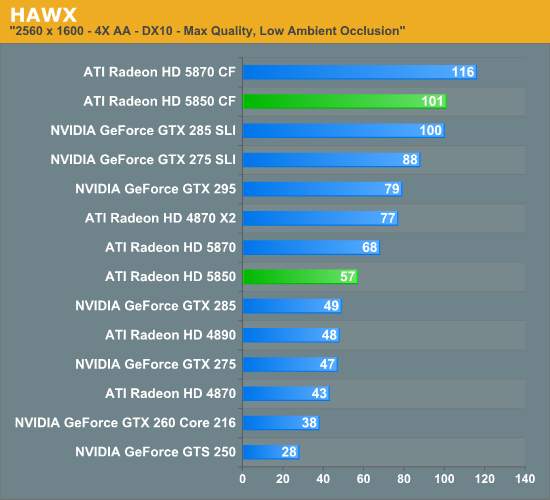
Once more the story is the 5850 coming in ahead of all single-GPU setups other than the 5870. However in Crossfire it beats the GTX 285 SLI by a single frame. A pattern is starting to emerge here with respect to multi-GPU performance.
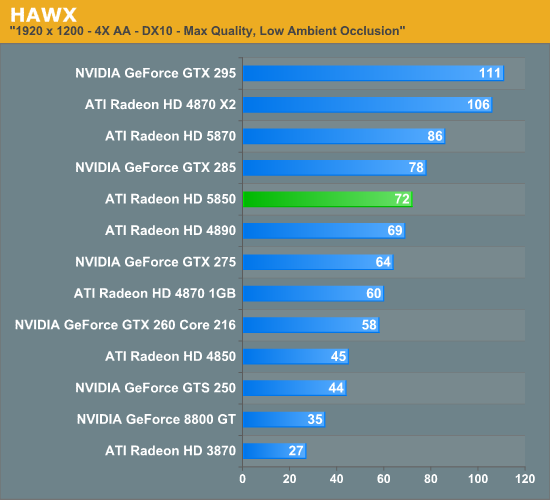
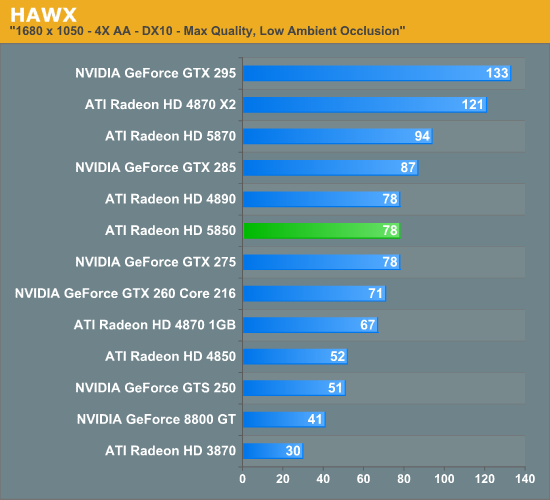
Dawn of War II
Dawn of War II is our other RTS benchmark. It’s among the more challenging games in our collection, leading to there being a definite cutoff for playability.
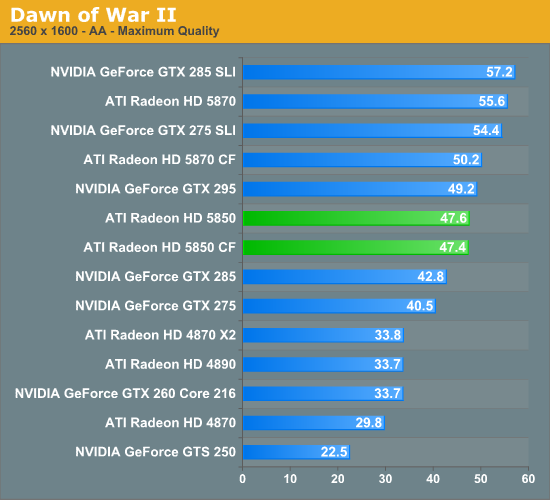
Dawn of War II continues to spite AMD multi-GPU configurations, with the 5850 Crossfire losing to the 5850 by a fraction of a frame. Meanwhile the 5850 Crossfire isn’t even close to the GTX 285 SLI, which still scales poorly but at least scales upwards in performance. In single card performance on the other hand, the 5850 does well, closing in on even the GTX 295 thanks to poor SLI scaling.
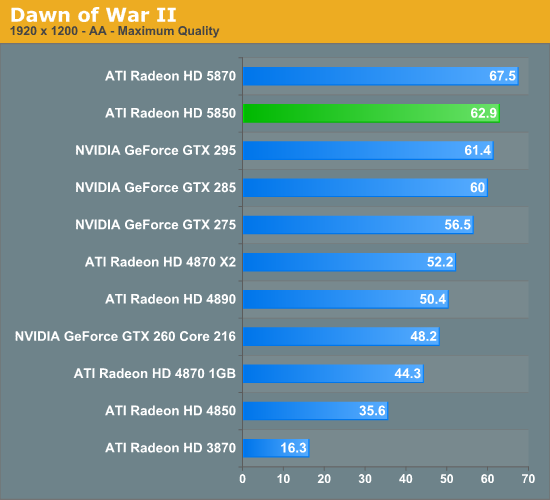
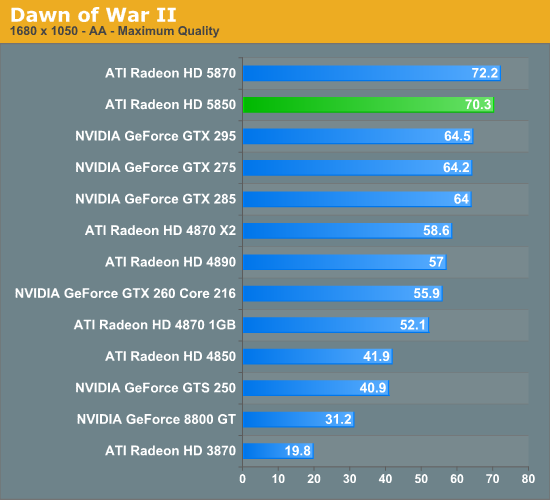
Resident Evil 5
The latest installment of Capcom’s popular survival horror series just arrived for PCs a few days ago. As is often the case with console ports, it’s not particularly GPU starved, and can crank out high numbers on just about anything.
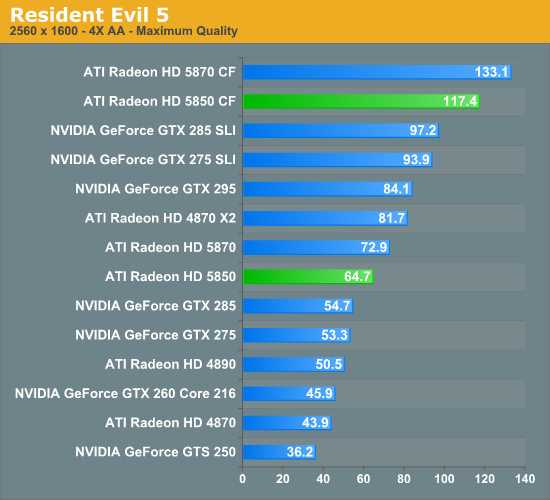
The 5850 once again defeats all earlier cards, and the 5850 Crossfire does the same to all multi-GPU solutions. Here we also see AMD’s fortunes reverse on the multi-GPU scaling front, where the GTX 285 SLI doesn’t beat the 5850 Crossfire like it has in past benchmarks.
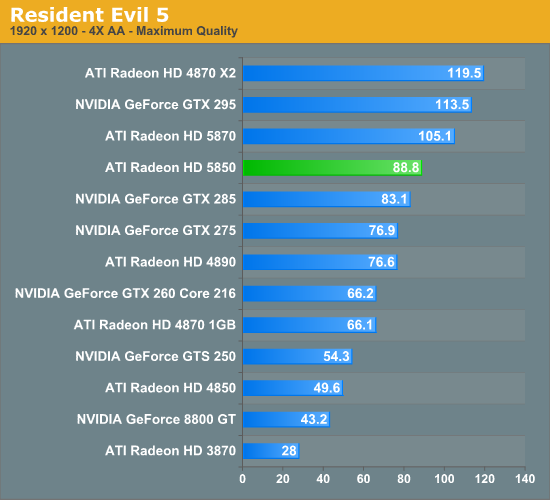
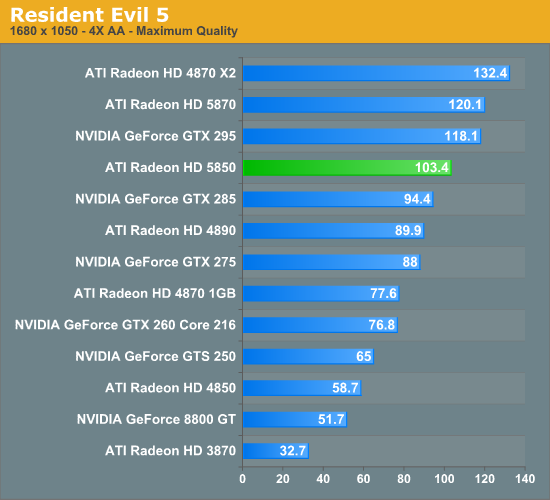
Batman: Arkham Asylum
Batman: Arkham Asylum is another brand-new PC game, and has been burning up the review charts. It’s an Unreal Engine 3 based game, something that’s not immediately obvious from just looking at it, which is rare for UE3 based games.
NVIDIA has put a lot of marketing muscle into the game as part of their The Way It’s Meant to Be Played program, and as a result it ships with PhysX support and 3D Vision support. Unfortunately NVIDIA’s influence has extended to its anti-aliasing abilities too, as its in-game selective AA abilities only work on NVIDIA’s cards. AMD’s cards can perform AA on the game, but only via traditional full screen anti-aliasing, which isn’t nearly as efficient. Because of this, this is the only game where we will not be using AA, as doing so produces meaningless results given the different AA modes used.
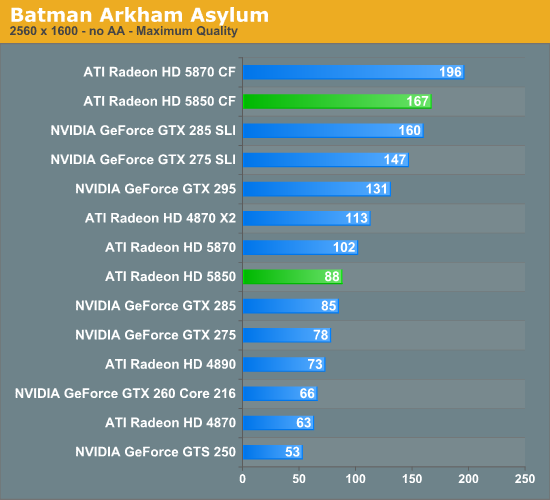
Since we can’t use AA, the name of the game is still “runaway performance”, with the 5850 bringing in 88fps. Meanwhile this is as close a gap between the 5850 and the GTX 285 as we’re going to see, with the 5850 beating the GTX 285 by only a few percent. The 5850 Crossfire maintains a similar gap, but doesn’t fall behind as it has in some tests.
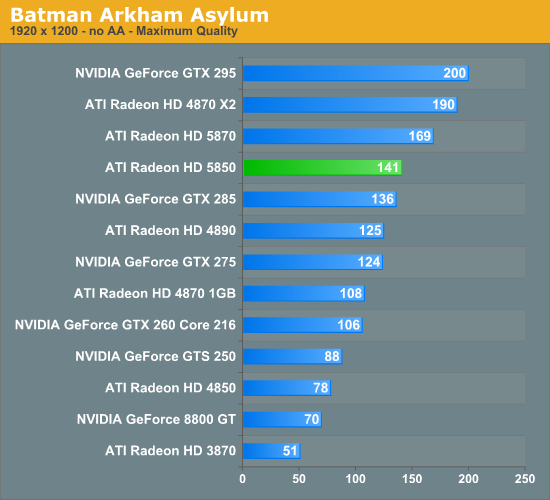
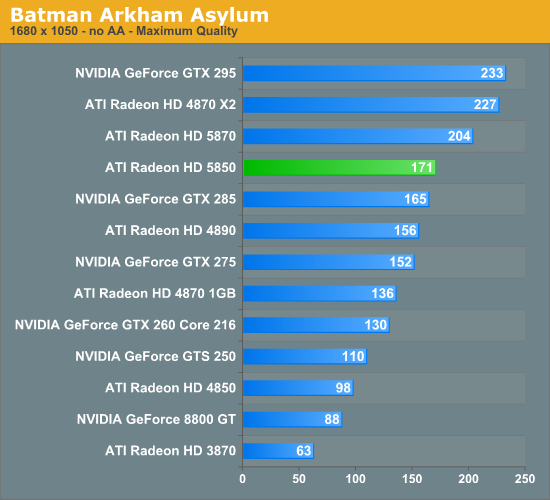
Left 4 Dead
Valve’s venerable Source engine continues to roll on with Left 4 Dead, their co-op zombie shooter. As the Source engine is CPU limited, this is once again going to be a collection of ridiculously high frame rates
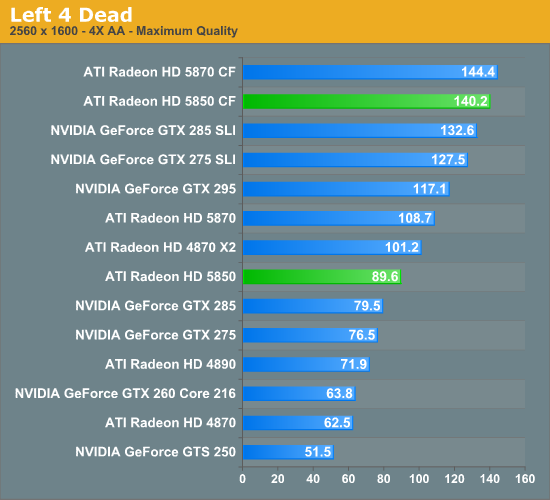
Once again we have a solid victory for the 5850 and 5850 Crossfire. We do see SLI scale better than Crossfire here, but it’s not enough to dethrone the 5850 Crossfire.
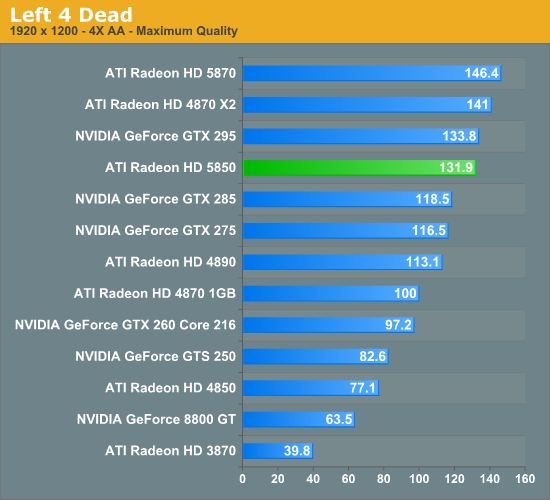
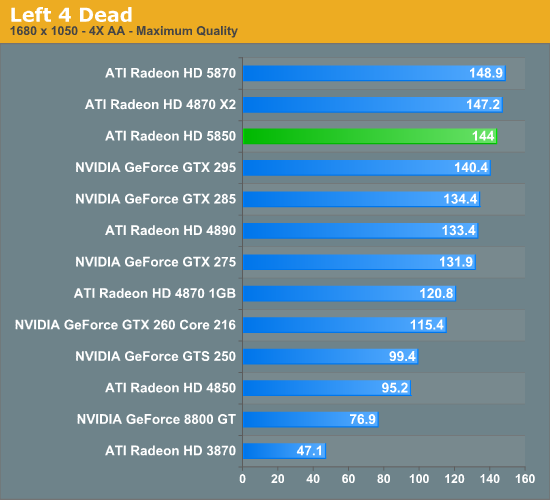
Power, Temperature, & Noise
With Cypress pared down some for the 5850, the power/temperature/noise situation takes on a different look. The 5870 ended up being hot, noisy, and more power-hungry than any other single-GPU setup under load. Let’s see if the 5850 can avoid that.
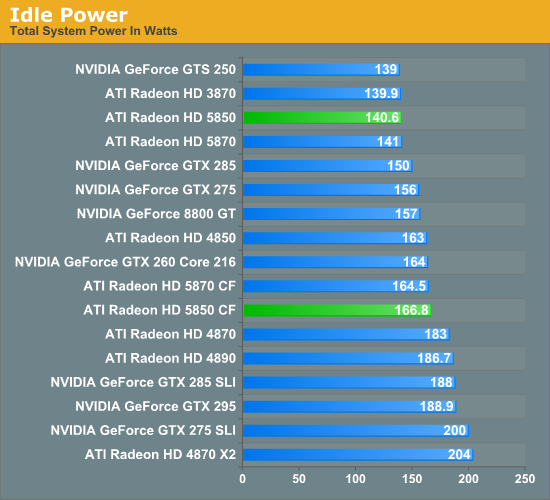
Looking at idle power, the results are the same as the 5870. This is to be expected as both are capable of reaching the same low idle power state. Crossfire results are similar, although the 5850 CF nudges itself higher than the 5870 CF on our charts; but this is within experimental variance.
As was the case with the 5870, the 5850 is among the lowest idling cards we have seen. It’s at the very bottom, only the Radeon HD 3870 and the GeForce GTS 250 can beat it, and even then just by a watt and a half.
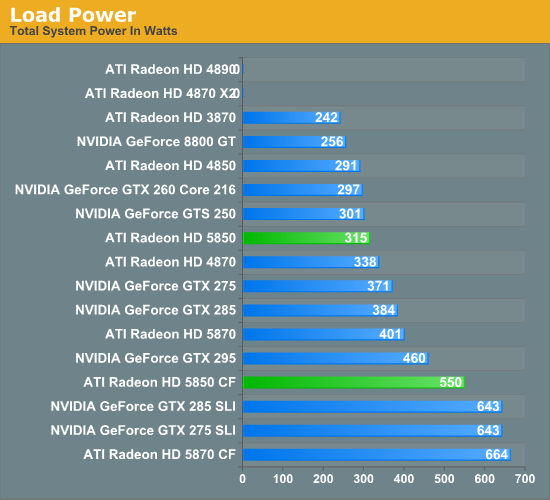
Load power on the other hand gives us a surprising difference. While the 5870 was one of the most power-hungry single-GPU cards we tested, the 5850 moves half-way down the chart. At load it uses less power than 4870 and most of the GTX series, in effect using less power than all of its closest performance competitors. In fact the difference in load power is beyond the specs; AMD’s specs call for a 37W difference, but here we have an 86W difference. Even after accounting for power supply inefficiencies, this is still a huge difference. We’re not seeing clock throttling occurring, so at this point we don’t have a complete explanation for what we’re seeing beyond the fact that we’re sure these are legitimate results.
The end result is that it’s clear that the 5850 is going to work well in systems with limited power abilities. At the same power envelope it’s significantly faster than anything else, and at the same performance level it’s significantly less power hungry than anything else.
As for Crossfire, this gap closes somewhat in that configuration. Here it’s only 114W under the 5870 CF, and just 93W under the GTX SLI cards. Even with its low power usage, the 5850 can’t erase the fact that multi-card solutions eat much more power than single-card solutions; it’s 90W over the GTX295, for example.
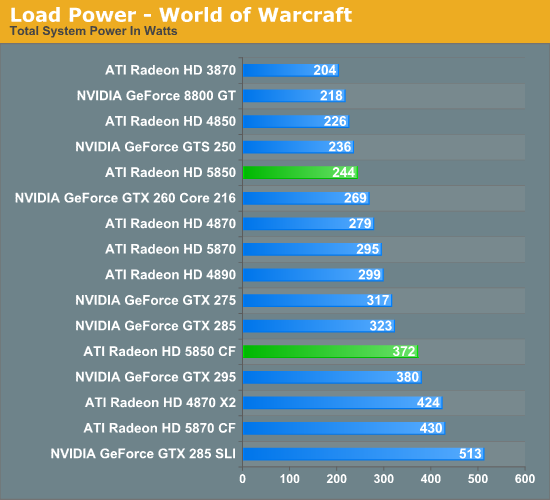
We’ll also take a look at power usage in Warcraft quickly, since it doesn’t trigger throttling in our other AMD cards. Warcraft doesn’t push these cards like OCCT does, so the overall power usage is lower, but the overall situation is virtually the same. The 5850 comes in at 55W less than the 5870, and this time bests the entire GTX lineup by at least 25W. We also see Crossfire do better here; now the 5850 CF can beat even multi-GPU cards like the 4870X2 and the GTX 295.
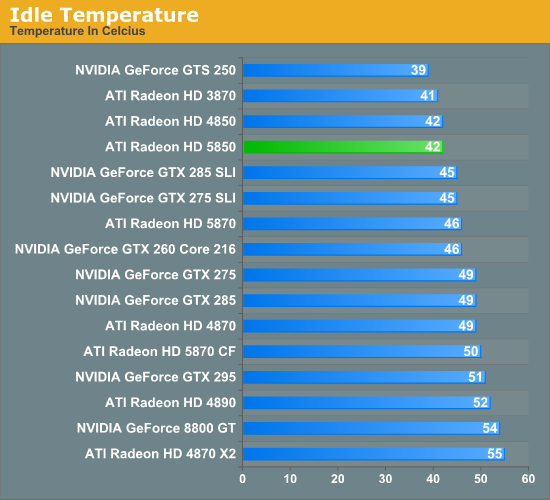
Interestingly enough, in spite of the same idle power as the 5870, the idle temps are not the same. The 5850 comes in at a chilly 42C, bringing it in line with the 4850 and the 3870. Only the GTS 250 can beat it by 3C, and in turn the 5850 beats its closest competitors, the GTX series, by at least 3C.
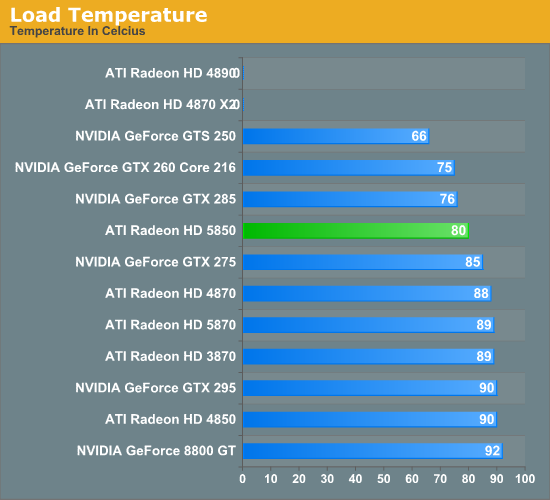
With lower power usage and a similar cooler, the 5850 is capable of keeping cooler than the 5870. While the 5870 approached 90C, the 5850 we’re testing was able to stay at 80C. This makes it the only AMD card we’ve tested that isn’t approaching 90C, which is good news for those of you with limited case ventilation. However it still loses to the GTS 250, and most of the GTX cards. We know NVIDIA is consuming more power, so clearly they have a more effective cooler in use if it’s able to cool their cards that well.
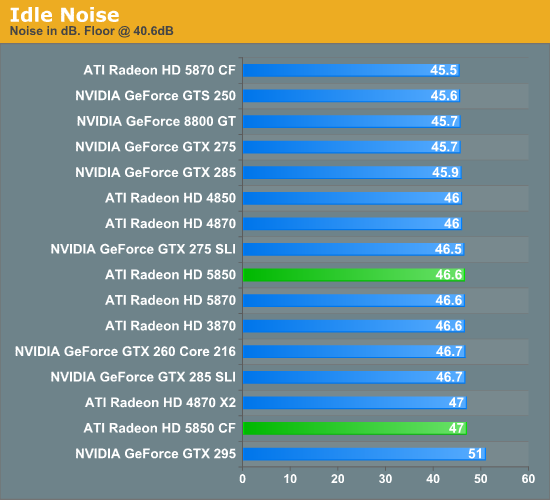
Finally we have noise. At idle virtually everything is the same, the 5850 and the 5870 come in at 46.6dB. To see a significant difference here, we would have to switch to a passively-cooled card.
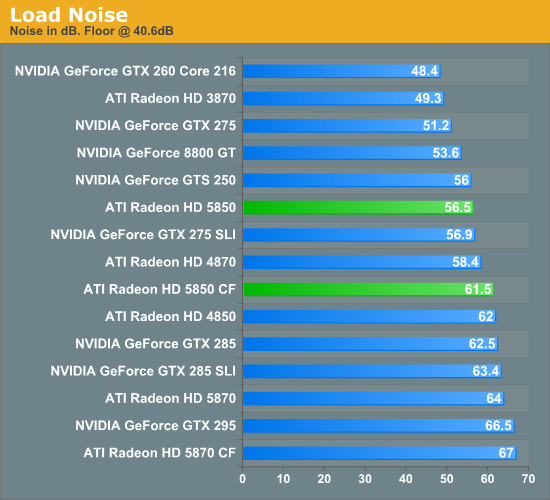
At load, the 5850 is just below the middle of the pack. Thankfully it’s not nearly as loud as the 5870, shaving off 8dB compared to its big brother and brings a Cypress-based card in to more reasonable territory. Adding a second card for Crossfire makes things louder at 61dB, but even that is still 6dB quieter than the 5870 CF.
This also shows us the tradeoffs NVIDIA made in cooling compared to AMD. The GTX 285, which was cooler running, is 6dB louder here as a result. Going by our charts the 5850 is fairly balanced in noise and temperature; it’s doesn’t need to make any trade-offs to achieve one or the other.
Conclusion
When you take the Cypress based Radeon HD 5870 and cut out 2 SIMDs and 15% of the clock speed to make a Radeon HD 5850, on paper you have a card 23% slower. In practice, that difference is only between 10% and 15% depending on the resolution. What’s not a theory is AMD’s pricing: they may have cut off 15% of the performance to make the 5850, but they have also cut the price by well more than 15%; 31% to be precise.
The result of this is clear: the 5870 is the fastest single-GPU card, and the 5850 is the value alternative. Couple that with the fact that it’s cooler running, quieter, shorter, and less power hungry, and you have a very interesting card. Design-wise the 5850 lets AMD get Cypress in to slightly smaller cases that can’t fit full 10.5” cards, something NVIDIA was never able to capitalize on with the reference GTX design (we actually had several comments on this; apparently a good number of people can’t fit 10.5” cards). The 5870/5850 situation ends up closely mirroring the 4870/4850 situation as a result; the 5870 is still the card to get when price (and size) is no object, but the 5850 is there to fill the gap if you won’t miss some of the performance.
One thing that’s very clear in these benchmarks is that as things currently stand, the 5850 has made the GTX 285 irrelevant (again). The 5850 is anywhere between 9% and 16% faster depending on the resolution, cheaper by at least $35 as of Tuesday morning (with everything besides a single BFG model going for +$70 or more), and features DirectX11. The 5850 is a card that manages to – if at times barely – outclass the GTX285 in performance. If you’ve been waiting for a price shakeup, this is what you’ve been waiting for.
Technically NVIDIA can get away with pricing the GTX285 anywhere under $260, but realistically its price needs to match its performance. With the 5850 having roughly 16% lead over the GTX 285 at 2560x1600, it doesn’t make much sense to pick up a GTX 285 unless prices fall a similar amount. This would be $225, which means lopping off at least $70 from the cheapest GTX285. If buyers believe that there’s any value in DX11, then NVIDIA would need to go even lower to offset that that gap, potentially as low at $200.
Meanwhile the $200-$225 range is the same price range the GTX 275 occupies. Cutting GTX 285 prices means cutting GTX 275 prices, which may require repricing the GTX 260, etc. NVIDIA’s response is going to bear watching if only to gauge what kind of cuts they can afford. Along the same lines we wouldn’t be surprised to see a GTX product retired due to price compression if NVIDIA can’t drop the price on the GTX 260 any further. Meanwhile vendor-overclocked cards will be the wildcard here; vendors can’t hope to completely close the gap, but the smaller performance gap will help them keep higher prices. Already we’re seeing fewer and fewer stock-clocked cards for sale compared to overclocked cards.
Update: We went window shopping again this afternoon to see if there were any GTX 285 price changes. There weren't. In fact GTX 285 supply seems pretty low; MWave, ZipZoomFly, and Newegg only have a few models in stock. We asked NVIDIA about this, but all they had to say was "demand remains strong". Given the timing, we're still suspicious that something may be afoot.
As for AMD, they’re in a much better pricing position. With the 4890 already priced under $200, the 5850 isn’t an immediate threat. If anything, the threat is a cheap GTX285 at the same price, which would outclass the 4890. It’s unlikely that the 5850 would be threatened on pricing, as we don’t expect NVIDIA to cut any more than they have to.
Moving on, we have the multi-GPU situation. While a pair of 5870s is the fastest dual-card setup out there, such a setup also pushes $760. A pair of 5850s won’t be as fast, but they also run for a far more palatable $520. Unfortunately Crossfire scaling just isn’t as good as SLI scaling in the tests we’ve seen; the performance gap varies wildly between games, and only averages 5% across all of them. If NVIDIA lowers the price on the GTX 285 enough, that 5% difference may end up a tossup. The 5850 still has better power performance and DX11, but it’s going to be easy to find the right price for the GTX 285 to nullify that. This is very close to being a draw.
Ultimately AMD is going to be spending at least the next few months in a very comfortable situation. They launched the world’s fastest single-GPU card last week, and they’re launching the world’s second-fastest single-GPU this week. Based on performance alone, from $220 up to the Radeon HD 5870’s price point, the Radeon HD 5850 is going to be the card to get. Meanwhile DirectX 11 is the icing on the cake that offers the 5800 series a greater lifespan and promise of future improvements in games.
For this fall, we're able to say something we haven't been able to say for quite some time: AMD has the high-end market locked up tight.







